Pine Tree Audio Rainbow HexaBraid Ribbon cables & XLR interconnects by Terry London
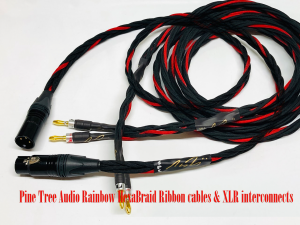
 Among other pleasures, one of the gratifying aspects of being a Stereo Times reviewer is when readers send me information regarding their findings of terrific new pieces of gear from small boutique manufacturers that are sold at very reasonable prices. The build quality and performance are often very high, the customer service is excellent, and the cost vs. performance is often remarkable. Last year, I received some emails from my readers inquiring if I was aware of Pine Tree Audio, which is located in Fitchburg, Massachusetts. They shared that they had replaced much more expensive speaker cables and interconnects in their systems with the wires from Pine Tree Audio and had raised the performance of their systems to a higher level.
Among other pleasures, one of the gratifying aspects of being a Stereo Times reviewer is when readers send me information regarding their findings of terrific new pieces of gear from small boutique manufacturers that are sold at very reasonable prices. The build quality and performance are often very high, the customer service is excellent, and the cost vs. performance is often remarkable. Last year, I received some emails from my readers inquiring if I was aware of Pine Tree Audio, which is located in Fitchburg, Massachusetts. They shared that they had replaced much more expensive speaker cables and interconnects in their systems with the wires from Pine Tree Audio and had raised the performance of their systems to a higher level.
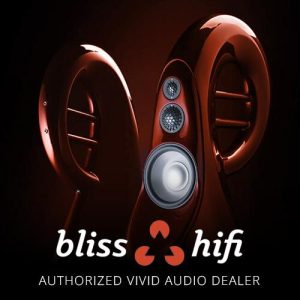 I was unaware of this small boutique company until the readers provided this information, which motivated me to educate myself about this producer of speaker wires, power cords, interconnects, linear power supplies, power filters, switching devices, and passive/active preamplifiers. Pine Tree Audio products are designed and hand-built in-house by the proprietor, Jesse Allain. When I contacted Jesse, it was apparent that he was highly informed and knowledgeable regarding all the parameters and theories of cable performance. He was also an expert on the materials and geometry of winding and building speaker cables and interconnects. He was delightful to converse with, for his wealth of information and ability to break down complex electrical concepts into clear and easy-to-understand terms. In our conversations, he explained the goals of his different wire looms based on their gauge and the type of materials he uses in the different models. When you call Pine Tree Audio, Jesse will be invaluable to you in clarifying what goals you are seeking in your system. Do you want total transparency/linearity, a touch of warmth, more shimmer in the high-end, or a smidgen of mid-bass for setting the foundation of the music in your rig? He will direct you to which speaker wires or cables are in his stable of products to get the results you seek, or suggest building you a customized pair to get you closer to your desired sonic goals. Another facet of interacting with Jesse that I found pretty enjoyable was that he was familiar with the “major players” in the audio cable market, would give his opinion regarding the shocking prices of some of their wires, but would never bad rap their products to aggrandize his speaker cables or interconnectors as you will see shortly the prices of Pine Tree Audio’s wires border on the ludicrous. This price structure is based on the hard-to-believe performance vs. price ratio. I know certain audiophiles who will dismiss these cables because they irrationally believe that something this inexpensive can’t be good. Based on my interactions with him, I understand why he has many loyal customers who keep full looms of Pine Tree Audio wires in their systems.
I was unaware of this small boutique company until the readers provided this information, which motivated me to educate myself about this producer of speaker wires, power cords, interconnects, linear power supplies, power filters, switching devices, and passive/active preamplifiers. Pine Tree Audio products are designed and hand-built in-house by the proprietor, Jesse Allain. When I contacted Jesse, it was apparent that he was highly informed and knowledgeable regarding all the parameters and theories of cable performance. He was also an expert on the materials and geometry of winding and building speaker cables and interconnects. He was delightful to converse with, for his wealth of information and ability to break down complex electrical concepts into clear and easy-to-understand terms. In our conversations, he explained the goals of his different wire looms based on their gauge and the type of materials he uses in the different models. When you call Pine Tree Audio, Jesse will be invaluable to you in clarifying what goals you are seeking in your system. Do you want total transparency/linearity, a touch of warmth, more shimmer in the high-end, or a smidgen of mid-bass for setting the foundation of the music in your rig? He will direct you to which speaker wires or cables are in his stable of products to get the results you seek, or suggest building you a customized pair to get you closer to your desired sonic goals. Another facet of interacting with Jesse that I found pretty enjoyable was that he was familiar with the “major players” in the audio cable market, would give his opinion regarding the shocking prices of some of their wires, but would never bad rap their products to aggrandize his speaker cables or interconnectors as you will see shortly the prices of Pine Tree Audio’s wires border on the ludicrous. This price structure is based on the hard-to-believe performance vs. price ratio. I know certain audiophiles who will dismiss these cables because they irrationally believe that something this inexpensive can’t be good. Based on my interactions with him, I understand why he has many loyal customers who keep full looms of Pine Tree Audio wires in their systems.
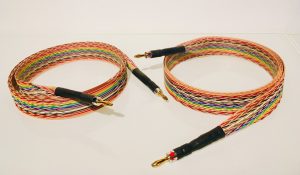
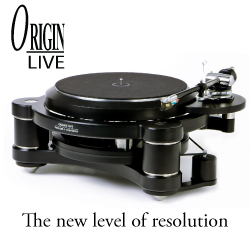 I chose to review two models of Pint Tree Audio cables. First up was the Rainbow Ribbon speaker wire, which retails for $170, for four individual 12-foot +/- wires per side. This cable comprises 26 x 28 AWG copper wires in a parallel/twisted pair for each ribbon. The Rainbow Ribbon speaker cable offered the virtues of total top-to-bottom linearity, an open layered sound stage, a high level of transparency so micro-details could be heard, an overall silky-smooth presentation, and an extended, airy open treble region. This cable allowed very good dynamic swings with a sense of speed and slam. If you seek a speaker cable that gets out of the way, not adding or subtracting from the signal it’s passing on, this might be what you want. My good friend and fellow Stereo Times reviewer, John Hoffman, replaced a more expensive pair of speaker wires with the Rainbow Ribbon cables because they brought the qualities I described above to a higher degree in his system than his older reference. The Rainbow Ribbons compete with wires in the $2000 to $3000 range. I had two other highly regarded speaker cables in-house for comparison, retailing around $2500 a pair, and the Pine Tree Audio Rainbow Ribbons were very competitive with them. Remember, these four individual ribbon runs, two wires +/- per channel, sell for $170! It’s hard to believe that Pine Tree Audio can stay solvent on such a reasonable profit margin.
I chose to review two models of Pint Tree Audio cables. First up was the Rainbow Ribbon speaker wire, which retails for $170, for four individual 12-foot +/- wires per side. This cable comprises 26 x 28 AWG copper wires in a parallel/twisted pair for each ribbon. The Rainbow Ribbon speaker cable offered the virtues of total top-to-bottom linearity, an open layered sound stage, a high level of transparency so micro-details could be heard, an overall silky-smooth presentation, and an extended, airy open treble region. This cable allowed very good dynamic swings with a sense of speed and slam. If you seek a speaker cable that gets out of the way, not adding or subtracting from the signal it’s passing on, this might be what you want. My good friend and fellow Stereo Times reviewer, John Hoffman, replaced a more expensive pair of speaker wires with the Rainbow Ribbon cables because they brought the qualities I described above to a higher degree in his system than his older reference. The Rainbow Ribbons compete with wires in the $2000 to $3000 range. I had two other highly regarded speaker cables in-house for comparison, retailing around $2500 a pair, and the Pine Tree Audio Rainbow Ribbons were very competitive with them. Remember, these four individual ribbon runs, two wires +/- per channel, sell for $170! It’s hard to believe that Pine Tree Audio can stay solvent on such a reasonable profit margin.

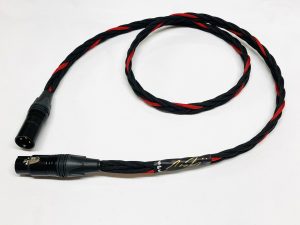
 Next up was my take on a complete loom of Pint Tree Audio HexaBraid SPC speaker wire, which retails for $440 for a 12-foot pair, and a pair of 1.5-meter HexaBraid SPC balanced XLR interconnects that retail for $240. The HexaBraid SPC cables comprise six SPC (silver-plated copper wire) in a nine-AWG symmetrical construction. The XLR interconnects are 15 AWG and are also constructed in a symmetrical design. They are terminated in high-quality Neutrik connectors. Like the Rainbow Ribbon speaker wires, the HexaBraid loom was built to a high-quality artisan level. I heard the following with the complete loom of the HexaBraid SPC cables.
Next up was my take on a complete loom of Pint Tree Audio HexaBraid SPC speaker wire, which retails for $440 for a 12-foot pair, and a pair of 1.5-meter HexaBraid SPC balanced XLR interconnects that retail for $240. The HexaBraid SPC cables comprise six SPC (silver-plated copper wire) in a nine-AWG symmetrical construction. The XLR interconnects are 15 AWG and are also constructed in a symmetrical design. They are terminated in high-quality Neutrik connectors. Like the Rainbow Ribbon speaker wires, the HexaBraid loom was built to a high-quality artisan level. I heard the following with the complete loom of the HexaBraid SPC cables.
- More micro-details could be heard through the different frequency ranges. It never turned into “bright” or “edgy,” but I heard the tiny minutia of these details more clearly.
- There was slightly more intensity in timbres/colors with the HexaBraid SPC loom than with the Rainbow Ribbon speaker wires. When I teamed the HexaBraid SPC XLRs with the Rainbow Ribbon cables, I heard the Rainbow Ribbon cables had easily passed on this quality.
- With the HexaBraid SPC loom, I experienced more “meat on the bones” imaging. If you run either planar speakers or electrostatic panels, this might be an excellent match for your system.
- Like the Rainbow Ribbon cables, the HexaBraid SPC wires had excellent overall dynamics and speed.
- The loom produced an open, spacious soundstage with a precise location of different players in that acoustic space.
Jesse designed the HexaBraid SPC cables to get a hybrid between the speed/details of silver wiring and the tonal warmth/fullness of copper wiring. He successfully achieved his design goals by trying the full loom of the HexaBraid SPC wires in three different systems. I would estimate that the HexaBraid SPC speaker wire and XLR interconnects gave me approximately 80% of the performance of my reference cables, which cost around $3500 a pair.
So, did the Pine Tree Audio Rainbow Ribbon speaker wires, HexaBraid SPC speaker wires, and HexaBraid SPC XLR interconnects convince me, after reviewing them, that my readers informed me about how satisfying these cables are in their performance and at the same time, reasonable price, were spot on? The answer is unequivocally yes, for all the reasons stated in the review. That’s why I made the Pine Tree Audio cables my budget cabling of the 2024 year for the Stereo Times “Most Wanted Components” list.


Specifications:
Website: www.pinetreeaudio.com
Associated Equipment
Source:
Pass Labs DAC-1
Reimyo DAP-999EX Toku DAC
Mark Levinson 31.5 transport
Por-Ject reference CD transport & LTA power supply
Wadia 22 transport
CEC T-3 transport
Amplification:
Coda 5.5 amplifier
SPL S1200 amplifier
Plinus SA-50 amplifier
Threshold 550e amplifier
AricAudio Super SET 300B amplifier
AricAudio Motherlode MKii preamplifier
SPL Elector preamplifier
Loudspeakers:
Tekton Design Ulfberht
Rosso Fiorentino Arno 40
NSMT System Two
Music Design Knight one
Tekton Design Encore Monitor
Accessories:
Jena Labs Symphony XLR ICs
Jena Labs Reference AES/EBU digital cable
Kirmuss Audio Adrenaline speaker wire
Krolo Design reference rack & footers
Puritan Audio power conditioner & grounding master system
Audio Archon power cords
Stereo Times Masthead
Publisher/Founder
Clement Perry
Editor
Dave Thomas
Senior Editors
Frank Alles, Mike Girardi, Russell Lichter, Terry London, Moreno Mitchell, Paul Szabady, Bill Wells, Mike Wright, and Stephen Yan,
Current Contributors
David Abramson, Tim Barrall, Dave Allison, Ron Cook, Lewis Dardick, John Hoffman, Dan Secula, Don Shaulis, Greg Simmons, Eric Teh, Greg Voth, Richard Willie, Ed Van Winkle, Rob Dockery, Richard Doran, and Daveed Turek
Site Management Clement Perry
Ad Designer: Martin Perry


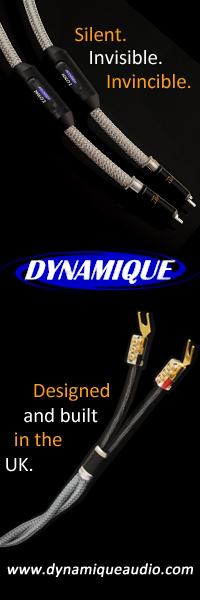


Be the first to comment on: Pine Tree Audio Rainbow HexaBraid Ribbon cables & XLR interconnects by Terry London